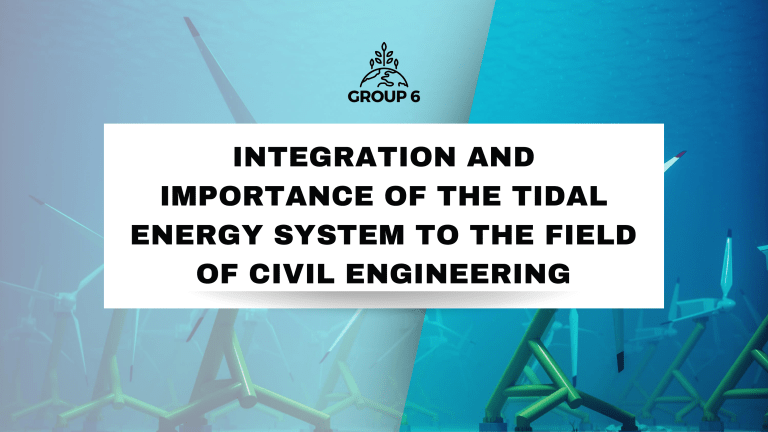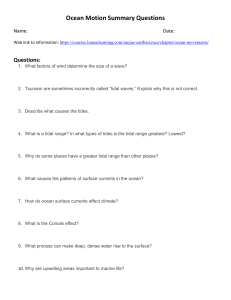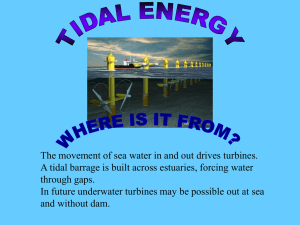Tidal Energy in Civil Engineering: Integration & Importance
advertisement

GROUP 6 INTEGRATION AND IMPORTANCE OF THE TIDAL ENERGY SYSTEM TO THE FIELD OF CIVIL ENGINEERING INTRODUCTION Tidal power , also called tidal energy , is a form of hydr opower which converts the energy of tides into the useful form of power, mainly in electr icity. Tides ar e per iodic r ise and fall of water level of sea which ar e caused by the action of sun and moon on the water on the earth. They are mainly caused by the gr avitational attraction of the Moon & Sun on the water of solid earth & Oceans INTRODUCTION The moon's force produces 70% of tides, resulting in two high and two low tides in two tidal cycles during a lunar day of 24 hour s and 50 minutes. The time between high and low tides in a specific location is appr ox imately six hours. The term flood tide is used to describe the situation where water levels r ise above the mean sea level. Ebb tide occur s when the tide level is below the mean level. This phenomenon can be harnessed to generate tidal power for electr icity. WORKING PRINCIPLE OF TIDAL POWER PLANT A d a m i s c o ns t ru c t e d i n s u c h a w a y t ha t a b a s i n ge t s s e p a ra t e d f ro m t he s e a a nd a d i f f e renc e i n t he w a t e r l e v e l i s o b t a i ne d b e t w e e n t he b a s i n a nd s e a . T he c o ns t ru c t e d b a si n i s fi l l ed d u ri ng hi gh ti d e a nd e mp t i e d d u ri ng l ow t i d e p a s s i ng t hro u gh t u rb i ne s. Pot e nt i a l e ne rgy of the wa te r store d i n t he b a s i n i s u s e d t o d ri v e t he t u rb i ne w hi c h i n t u rn ge ne ra t e s e l e c t ri ci t y a s i t i s d i re c t l y c o u p l e d t o a n a l t e rna t o r. The generati o n of power stops only when the sea level and the tidal basin level are equal. For the generati o n of power economic all y using this source of energy requires some minimu m tide height and suitable site. EXAMPLES Kislaya power plant Rance power plant Russia France MAIN PARTS OF TIDAL POWER PLANT Barrage Sluice Gate Turbine and Generator Holds the water back during the hightide Makes the water passes Resulting in electricit y generation TIDAL BARRAGE A tidal barrage is a dam-like structure used to capture the energy from masses of water moving in and out of a bay or river due to tidal forces. SLUICE GATES The sluice gates are left open during high tide and closed during low tide to create a water level differential, creating a potential difference that powers the turbine when the water is released. TIDAL STREAM GENERATOR 01 02 03 Tidal stream generators are very similar to wind turbines except their below the water surface instead of above or on land. The turbine and generator converts the movement of water coming from change in tide, the kinetic energy, into electricity. Water is 830 times denser than air and therefore can generate electricity at lower speeds than wind turbines. TIDAL ENERGY SIGNIFICANT ROLES Reduced Carbon Footprint: Ti dal energy systems pro duce electrici ty wi thout emi tting greenhouse gases, co ntributi ng to the reduction o f carbon footprints associated wi th conventional energy sources . TIDAL ENERGY SIGNIFICANT ROLES Infrastructure Development: Civil engineers play a c rucial role in designing these structures to withstand t he harsh marine environment and ensure effici ent energy conversion . Requires the design and construction of specialized infrastructure, including tidal turbines, bar r ages, and other supporting structures . TIDAL ENERGY SIGNIFICANT ROLES Coastal Protection and Flood Control: Tidal ene rgy systems, such as tidal barrages, can also serve as coastal protection infrastructure by reducing the impact of storm surges and tidal flooding . TIDAL ENERGY SIGNIFICANT ROLES Resource Assessment and Site Selection: Civil engineers are in volved in ass essin g tidal energ y resource s and selec ting suitable sites for installation . They us e their expertise in geotechnic al enginee ring, structural enginee ring, and coastal eng ineerin g to evaluate th e feasibility and sustai nability of tidal energy projects. TIDAL ENERGY SIGNIFICANT ROLES Structural Design and Stability: Civil engineers are involved in asse ssing tidal energ y re sources an d sele cting suitable sites fo r install ation . They us e their expertis e in geotech nical engineering, struc tural engineeri ng, and coastal enginee ring to evaluate the fe asibility and sustainability of tidal energy projects .





